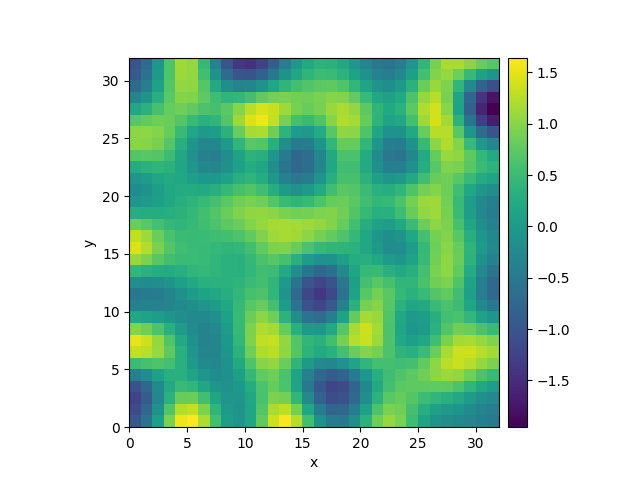Note
Go to the end to download the full example code
2.6 Kuramoto-Sivashinsky - Using PDE class
This example implements a scalar PDE using the PDE. We here
consider the Kuramoto–Sivashinsky equation, which for instance
describes the dynamics of flame fronts:
\[\partial_t u = -\frac12 |\nabla u|^2 - \nabla^2 u - \nabla^4 u\]

0%| | 0/10.0 [00:00<?, ?it/s]
Initializing: 0%| | 0/10.0 [00:00<?, ?it/s]
0%| | 0/10.0 [00:15<?, ?it/s]
0%| | 0.01/10.0 [00:25<7:11:47, 2593.35s/it]
0%| | 0.02/10.0 [00:25<3:35:40, 1296.69s/it]
1%| | 0.11/10.0 [00:25<38:51, 235.77s/it]
53%|█████▎ | 5.35/10.0 [00:25<00:22, 4.85s/it]
53%|█████▎ | 5.35/10.0 [00:25<00:22, 4.85s/it]
100%|██████████| 10.0/10.0 [00:25<00:00, 2.60s/it]
100%|██████████| 10.0/10.0 [00:25<00:00, 2.60s/it]
from pde import PDE, ScalarField, UnitGrid
grid = UnitGrid([32, 32]) # generate grid
state = ScalarField.random_uniform(grid) # generate initial condition
eq = PDE({"u": "-gradient_squared(u) / 2 - laplace(u + laplace(u))"}) # define the pde
result = eq.solve(state, t_range=10, dt=0.01)
result.plot()
Total running time of the script: (0 minutes 26.136 seconds)